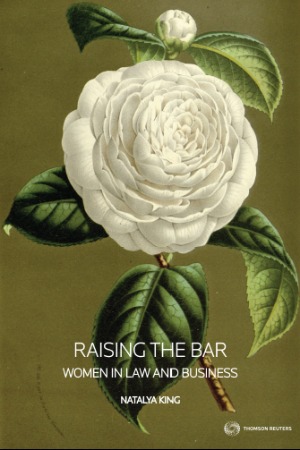Raising the Bar – Women in Law and Business reviewed by Wendy Aldred
Raising the Bar – Women in Law and Business squarely confronts the the question of why women lawyers leave the profession and do not progress to senior levels in law firms.
 Natalya King’s Raising the Bar – Women in Law and Business squarely confronts the the question of why women lawyers leave the profession and do not progress to senior levels in law firms. The problem has been around for a long time (women law graduates have outnumbered their male counterparts for more than 20 years now) but until recently has remained largely unaddressed by employers, the Law Society and to some extent, the wider profession.
Natalya King’s Raising the Bar – Women in Law and Business squarely confronts the the question of why women lawyers leave the profession and do not progress to senior levels in law firms. The problem has been around for a long time (women law graduates have outnumbered their male counterparts for more than 20 years now) but until recently has remained largely unaddressed by employers, the Law Society and to some extent, the wider profession.
This impressive work provides a comprehensive assessment of the problem, its history, causes, and what might be done to improve the outlook for women in the law, with a focus on employment within law firms and corporates. In the opening chapter, King expresses the hope that her book will serve as a practical manual for businesses that want to improve their gender balance, “and with that, arguably their profits,” and she has taken care throughout to ensure that the book remains true to this objective.
The business case for gender diversity within organisations is put convincingly in chapter 3, with ample reference to a range of international research, and leaves the reader wondering how this can have been missed, especially perhaps by the larger law firms, for so long.
The book is packed with interesting facts and figures – the timeline of New Zealand women’s history in law, business and politics at chapter 5 is remarkable for showing up both where New Zealand has been a world leader, and where it has lagged behind. King surveys initiatives put in place by overseas corporates and other businesses in New Zealand. The reader is left with the distinct impression that New Zealand law firms have so far lacked determination and imagination in the way they have tackled the diversity issue.
The legislative environment is discussed, with an outline of the significant legislation impacting the employment of women including the Human Rights Act and parental leave legislation. A whole chapter is devoted to the important topic of equal pay and pay equity, with a clear explanation of the distinction between the two concepts and guidelines for employers who wish to address “pay gaps” in their organisations.
Chapter 7 (Women in New Zealand’s Legal Profession) reviews the status quo, and outlines the results of various recent research which provides a profile of where women are within the profession. There is evidently a rather depressing disjunct between the aspirations of women respondents involved in some of the research - largely, flexible working arrangements being available without impeding progression - and what some of the senior partners of law firms are prepared to countenance. The toe-curling experiences of women the author has interviewed who have been on the receiving end of good old-fashioned sexism are related, showing that in cultural terms, the profession has a long way to go.
But the truly commendable thing about Raising the Bar is that King has clearly concentrated her efforts on demonstrating that the problems she outlines are not intractable.
But the truly commendable thing about Raising the Bar is that King has clearly concentrated her efforts on demonstrating that the problems she outlines are not intractable. She identifies practical tools and strategies that employers can use to improve the outlook for women employees, and, by doing so, improve their own organisational culture and performance.
Chapter 10 contains case studies of three Corporates Leading the Way – detailing the measures that three large New Zealand companies (including one of the large accountancy firms, but no law firms) have taken to empower women in the workplace.
Chapter 11 (Tools for Change) provides employers with a clear set of guidelines for identifying and addressing problems, setting out ten suggested steps to implementing meaningful organisational change. In this way, the book managed to leave me feeling relatively optimistic about the potential for change, rather than angry about the apparent lack of progress to date. It reads as issuing a challenge to employers to up their game, and also, to some extent, to women lawyers to keep the pressure on.
While, because of its subject matter and structure, the book lends itself to being dipped into by the reader, I found myself reading it from beginning to end, with the range of subject matter being sufficient to maintain interest. The references to conversations that King has had with female colleagues as part of her wide research are refreshing and often entertaining, too.
I found the book comprehensive in its treatment of the issues it sets out to address, and the subject matter itself lends itself to the exploration of related topics.
The experiences of other groups that have traditionally been underrepresented at the higher levels of the legal profession and in business and what should be done to address diversity issues in the broader sense are touched on in the book and this is another area that lends itself to more detailed study.
King has aimed her work particularly at medium sized businesses: many women are employed outside of this model, so further work might concentrate on women in small law firms or business, or the issue of why women are under-represented at the independent Bar and as sole practitioners. The latter is of particular interest to me as a barrister: self-employment, properly managed, can provide flexibility without permission.
The notion that it might not just be organisations that employ women, but also “structural” features of the legal system itself and the nature of legal work that impede women’s progression is also worthy of exploration: the court management system, for example, could do more to accommodate the fact that women lawyers in particular are more likely to have commitments outside of the law.
I congratulate Natalya King on this brave and impressive work, and would commend Raising the Bar to law firms and corporates of any size, as well of course as to all women in law and business.
Wendy Aldred
Barrister, Central Chambers
Convenor, Wellington Women Lawyers’ Association
About the book
Raising the Bar: Women in Law and Business examines the progress and participation of women in New Zealand’s legal and professional services industries, and presents a practical blueprint for positive change.
It takes a close look at the way in which women’s progress has stagnated over the last twenty years, and analyses the legislative, policy and social reasons for such stagnation. The book breaks down international research to explain the societal benefits of gender diversity, and, in particular, how diversity within a business increases profit and productivity.
About the author
 Natalya King’s book Raising the Bar started life as a Master’s thesis, focusing solely on women in the legal profession. It was a result of her questioning other female law students about how their careers would map out and in particular, how they could combine career and family. The scope grew as she became more and more fascinated with the subject.
Natalya King’s book Raising the Bar started life as a Master’s thesis, focusing solely on women in the legal profession. It was a result of her questioning other female law students about how their careers would map out and in particular, how they could combine career and family. The scope grew as she became more and more fascinated with the subject.